Business Management Report: Nike's CSR, Ethical Issues, and Teamwork
VerifiedAdded on 2020/01/23
|7
|1632
|333
Report
AI Summary
This report provides an analysis of Nike, a multinational corporation engaged in designing, developing, manufacturing, and marketing globally. The report begins with an introduction to business management, defining key elements such as employees, operations, accounting, strategy, finance, and marketing. It then delves into Carroll's Corporate Social Responsibility (CSR) Pyramid, illustrating how Nike can fulfill its social responsibilities through economic, legal, ethical, and philanthropic responsibilities. The report identifies several ethical issues faced by Nike, including industrial espionage, environmental concerns, employee relations, and consumer relations. Finally, it explores the challenges and benefits of teamwork within Nike, highlighting the advantages of better solutions and creative problem-solving, while also acknowledging potential issues like a lack of diverse skills and poor communication. The report concludes by emphasizing the importance of proper skills, effective communication, and knowledge in achieving business goals.
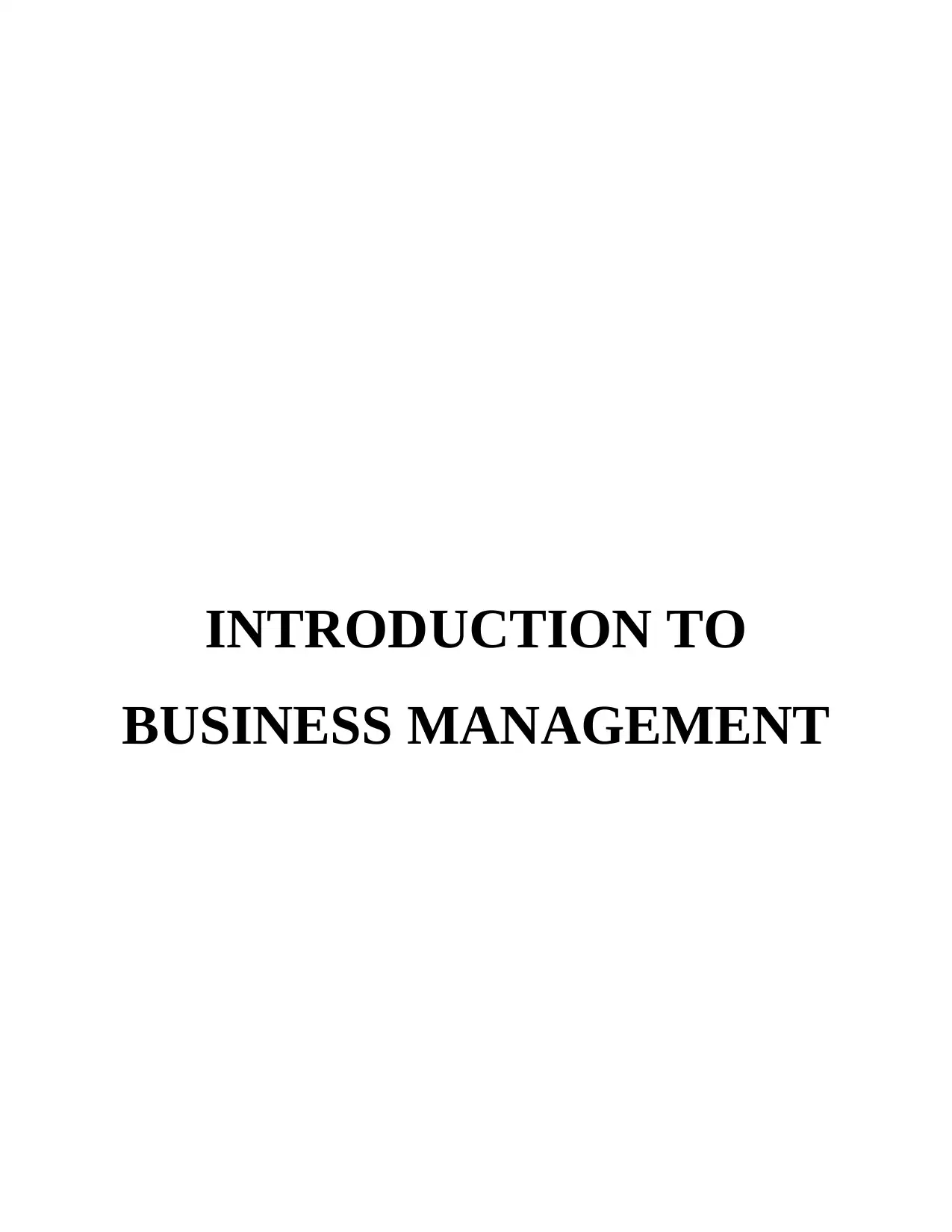
INTRODUCTION TO
BUSINESS MANAGEMENT
BUSINESS MANAGEMENT
Paraphrase This Document
Need a fresh take? Get an instant paraphrase of this document with our AI Paraphraser
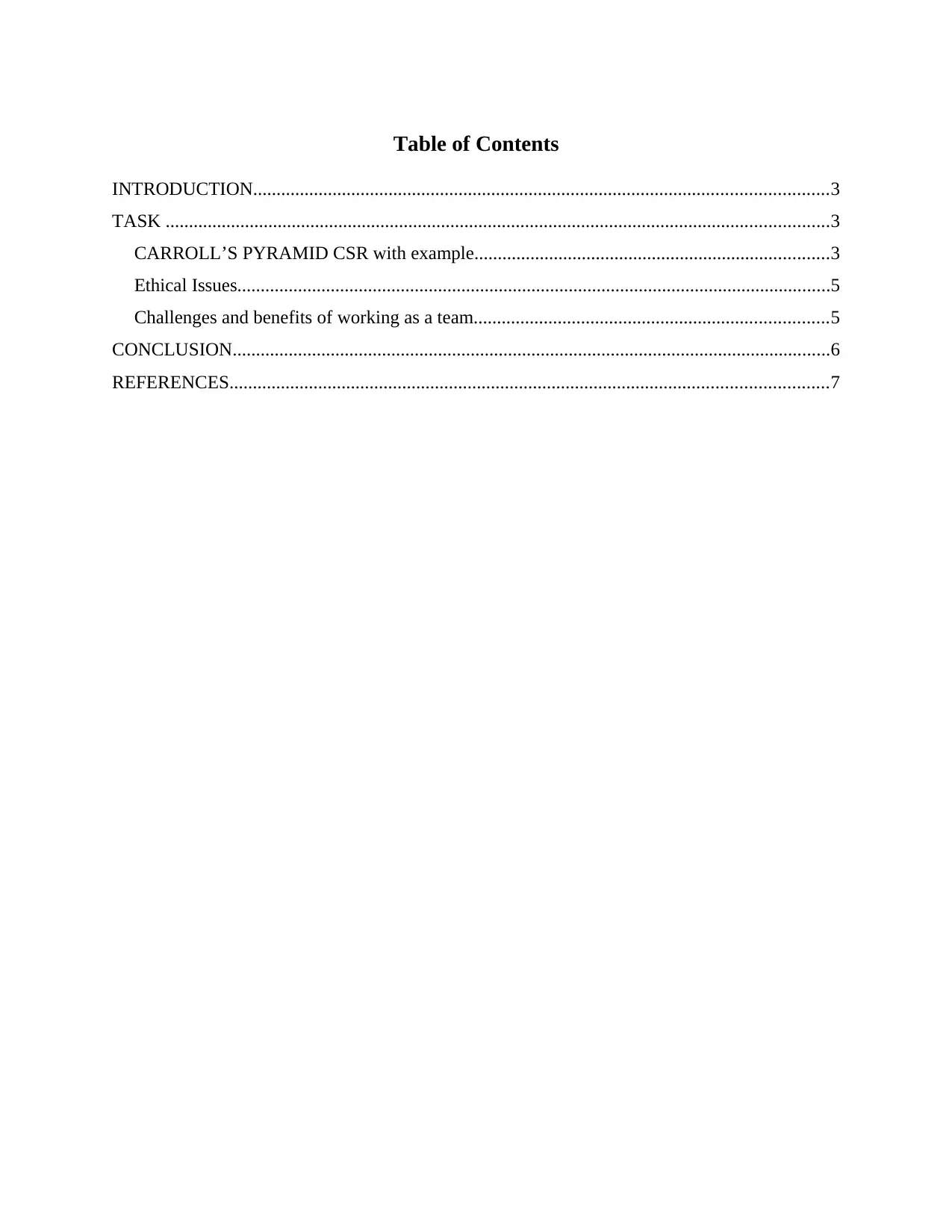
Table of Contents
INTRODUCTION...........................................................................................................................3
TASK ..............................................................................................................................................3
CARROLL’S PYRAMID CSR with example............................................................................3
Ethical Issues...............................................................................................................................5
Challenges and benefits of working as a team............................................................................5
CONCLUSION................................................................................................................................6
REFERENCES................................................................................................................................7
INTRODUCTION...........................................................................................................................3
TASK ..............................................................................................................................................3
CARROLL’S PYRAMID CSR with example............................................................................3
Ethical Issues...............................................................................................................................5
Challenges and benefits of working as a team............................................................................5
CONCLUSION................................................................................................................................6
REFERENCES................................................................................................................................7
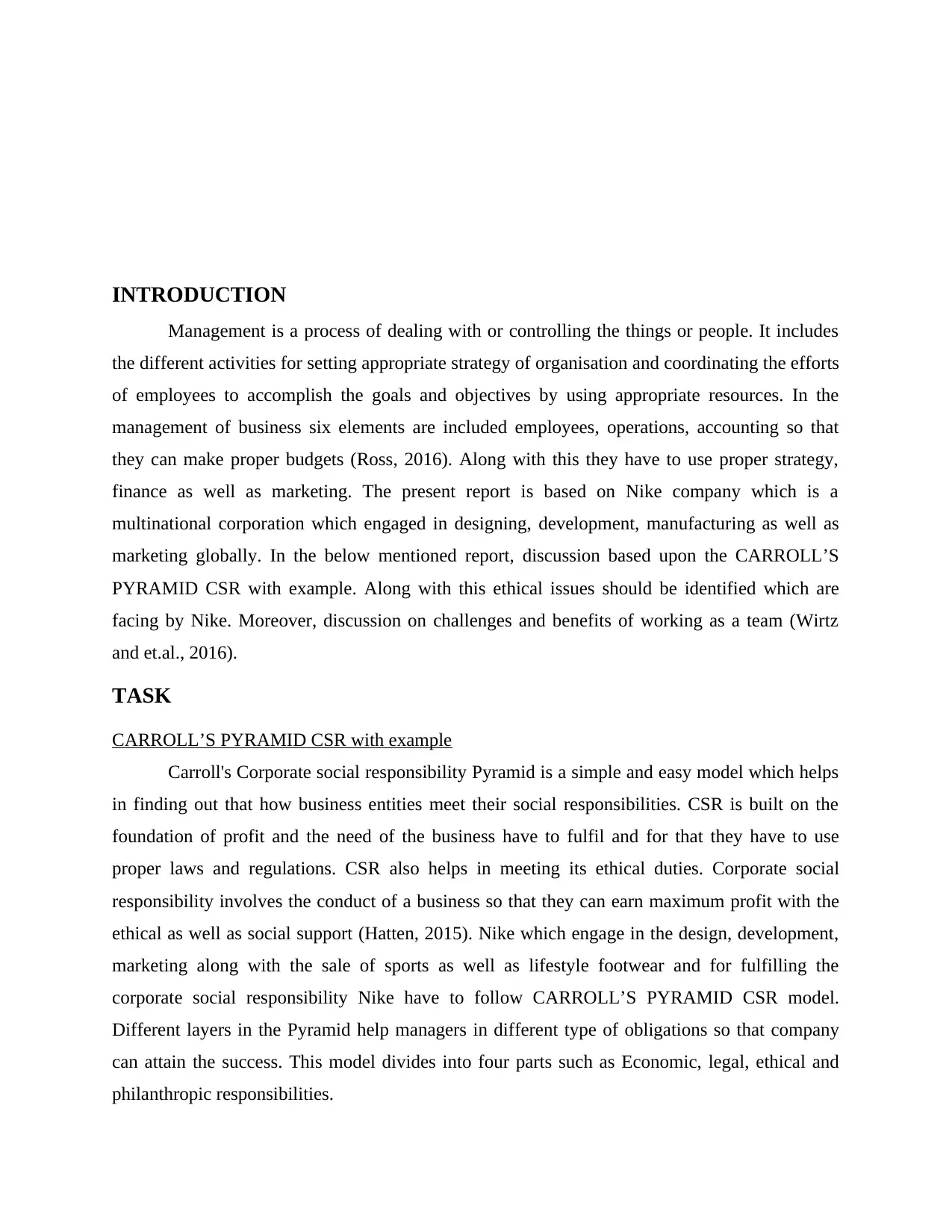
INTRODUCTION
Management is a process of dealing with or controlling the things or people. It includes
the different activities for setting appropriate strategy of organisation and coordinating the efforts
of employees to accomplish the goals and objectives by using appropriate resources. In the
management of business six elements are included employees, operations, accounting so that
they can make proper budgets (Ross, 2016). Along with this they have to use proper strategy,
finance as well as marketing. The present report is based on Nike company which is a
multinational corporation which engaged in designing, development, manufacturing as well as
marketing globally. In the below mentioned report, discussion based upon the CARROLL’S
PYRAMID CSR with example. Along with this ethical issues should be identified which are
facing by Nike. Moreover, discussion on challenges and benefits of working as a team (Wirtz
and et.al., 2016).
TASK
CARROLL’S PYRAMID CSR with example
Carroll's Corporate social responsibility Pyramid is a simple and easy model which helps
in finding out that how business entities meet their social responsibilities. CSR is built on the
foundation of profit and the need of the business have to fulfil and for that they have to use
proper laws and regulations. CSR also helps in meeting its ethical duties. Corporate social
responsibility involves the conduct of a business so that they can earn maximum profit with the
ethical as well as social support (Hatten, 2015). Nike which engage in the design, development,
marketing along with the sale of sports as well as lifestyle footwear and for fulfilling the
corporate social responsibility Nike have to follow CARROLL’S PYRAMID CSR model.
Different layers in the Pyramid help managers in different type of obligations so that company
can attain the success. This model divides into four parts such as Economic, legal, ethical and
philanthropic responsibilities.
Management is a process of dealing with or controlling the things or people. It includes
the different activities for setting appropriate strategy of organisation and coordinating the efforts
of employees to accomplish the goals and objectives by using appropriate resources. In the
management of business six elements are included employees, operations, accounting so that
they can make proper budgets (Ross, 2016). Along with this they have to use proper strategy,
finance as well as marketing. The present report is based on Nike company which is a
multinational corporation which engaged in designing, development, manufacturing as well as
marketing globally. In the below mentioned report, discussion based upon the CARROLL’S
PYRAMID CSR with example. Along with this ethical issues should be identified which are
facing by Nike. Moreover, discussion on challenges and benefits of working as a team (Wirtz
and et.al., 2016).
TASK
CARROLL’S PYRAMID CSR with example
Carroll's Corporate social responsibility Pyramid is a simple and easy model which helps
in finding out that how business entities meet their social responsibilities. CSR is built on the
foundation of profit and the need of the business have to fulfil and for that they have to use
proper laws and regulations. CSR also helps in meeting its ethical duties. Corporate social
responsibility involves the conduct of a business so that they can earn maximum profit with the
ethical as well as social support (Hatten, 2015). Nike which engage in the design, development,
marketing along with the sale of sports as well as lifestyle footwear and for fulfilling the
corporate social responsibility Nike have to follow CARROLL’S PYRAMID CSR model.
Different layers in the Pyramid help managers in different type of obligations so that company
can attain the success. This model divides into four parts such as Economic, legal, ethical and
philanthropic responsibilities.
⊘ This is a preview!⊘
Do you want full access?
Subscribe today to unlock all pages.

Trusted by 1+ million students worldwide
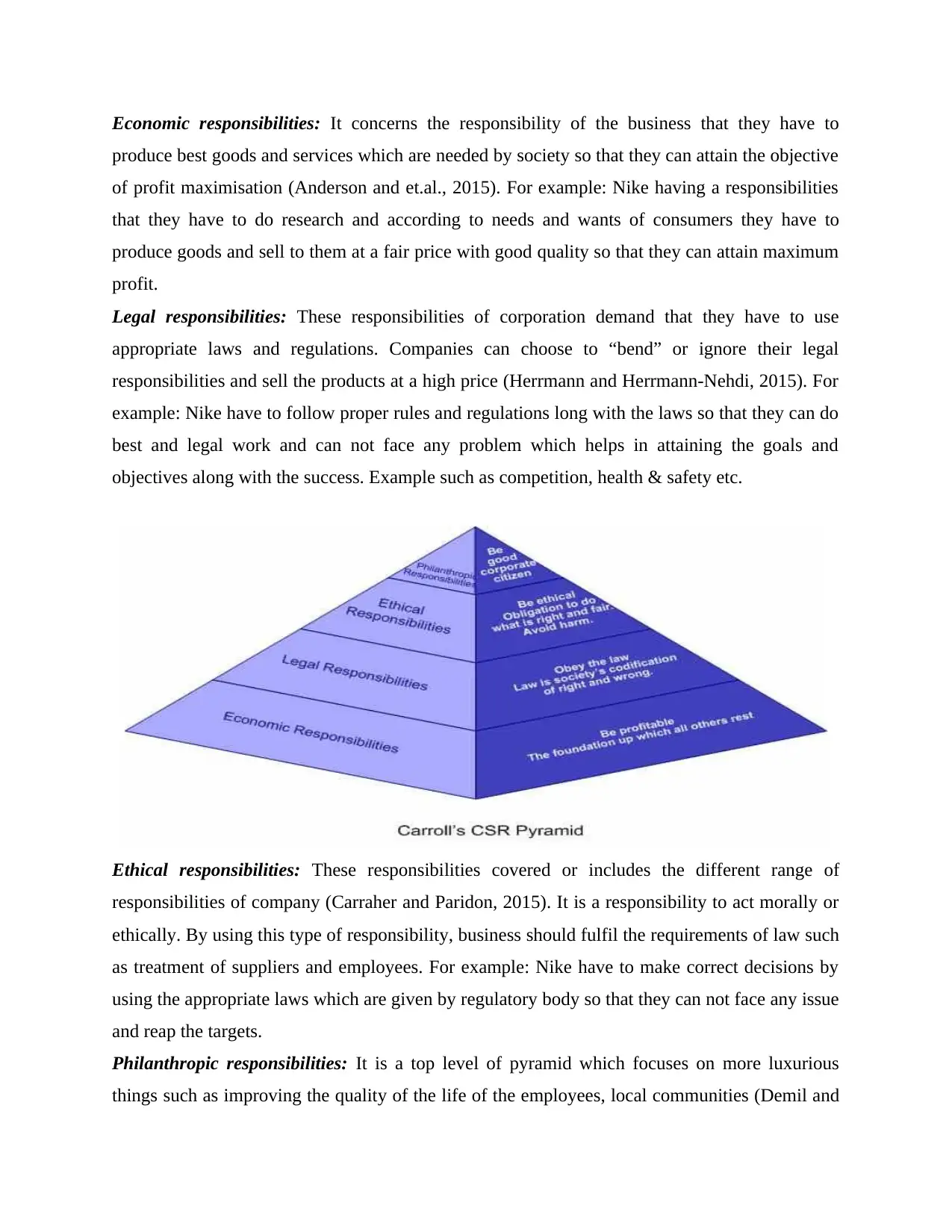
Economic responsibilities: It concerns the responsibility of the business that they have to
produce best goods and services which are needed by society so that they can attain the objective
of profit maximisation (Anderson and et.al., 2015). For example: Nike having a responsibilities
that they have to do research and according to needs and wants of consumers they have to
produce goods and sell to them at a fair price with good quality so that they can attain maximum
profit.
Legal responsibilities: These responsibilities of corporation demand that they have to use
appropriate laws and regulations. Companies can choose to “bend” or ignore their legal
responsibilities and sell the products at a high price (Herrmann and Herrmann-Nehdi, 2015). For
example: Nike have to follow proper rules and regulations long with the laws so that they can do
best and legal work and can not face any problem which helps in attaining the goals and
objectives along with the success. Example such as competition, health & safety etc.
Ethical responsibilities: These responsibilities covered or includes the different range of
responsibilities of company (Carraher and Paridon, 2015). It is a responsibility to act morally or
ethically. By using this type of responsibility, business should fulfil the requirements of law such
as treatment of suppliers and employees. For example: Nike have to make correct decisions by
using the appropriate laws which are given by regulatory body so that they can not face any issue
and reap the targets.
Philanthropic responsibilities: It is a top level of pyramid which focuses on more luxurious
things such as improving the quality of the life of the employees, local communities (Demil and
produce best goods and services which are needed by society so that they can attain the objective
of profit maximisation (Anderson and et.al., 2015). For example: Nike having a responsibilities
that they have to do research and according to needs and wants of consumers they have to
produce goods and sell to them at a fair price with good quality so that they can attain maximum
profit.
Legal responsibilities: These responsibilities of corporation demand that they have to use
appropriate laws and regulations. Companies can choose to “bend” or ignore their legal
responsibilities and sell the products at a high price (Herrmann and Herrmann-Nehdi, 2015). For
example: Nike have to follow proper rules and regulations long with the laws so that they can do
best and legal work and can not face any problem which helps in attaining the goals and
objectives along with the success. Example such as competition, health & safety etc.
Ethical responsibilities: These responsibilities covered or includes the different range of
responsibilities of company (Carraher and Paridon, 2015). It is a responsibility to act morally or
ethically. By using this type of responsibility, business should fulfil the requirements of law such
as treatment of suppliers and employees. For example: Nike have to make correct decisions by
using the appropriate laws which are given by regulatory body so that they can not face any issue
and reap the targets.
Philanthropic responsibilities: It is a top level of pyramid which focuses on more luxurious
things such as improving the quality of the life of the employees, local communities (Demil and
Paraphrase This Document
Need a fresh take? Get an instant paraphrase of this document with our AI Paraphraser

et.al., 2015). This is a responsibility to give back to society and it is discretionary in nature but it
is important such as charitable donations, staff time on projects which assist in obtaining the
leading position in the competitive market and also attain objectives which is profit
maximisation.
Ethical Issues
There are some ethical issues which Nike is facing that is industrial espionage, relation
with the environment, relation with the employees, relation with the consumers. Industrial
espionage is a illegal method which transnational corporations use to attain the success from
competitors (Verhoef, Kannan and Inman, 2015). Another is relation with the environment. Nike
must respect to the national legislation for the environment protection and for that they have to
make products which helps in protecting the environment.
Relation with the employees is the another aspect in which manager of Nike have to
make ethical decisions without any compromise. The employees get involved in completing the
task for the success of Nike in the competitive market. Next is relation with the consumers. In
which employees of Nike have to do effective communication to them so that they can easily
purchase their products and by that they can improve sales and attain maximum revenue (Pullen
and Rhodes, 2015).
Challenges and benefits of working as a team
Team become increasing a prominent part of the business entity (Kidwell and Doherty,
2015). Work team provides and offers some benefits because of the collaboration of some
employees of Nike but in this challenges also exist which helps in attaining targets.
Benefits – By doing the work in a team they get better solution of any query or problem. They
have to derive better quality and get more creative solutions to resolve the problems. Along with
the better quality Nike can do the better production of the products and services so that they can
accomplish the goals and objectives (Head and Alford, 2015).
Challenges – There are some challenges which are faced by the employees when they are
working in a team. Some employees in a team having a lack of diverse skills as well as interests
so that purpose of working in a team can not achieved (Serra and Kunc, 2015). Another is poor
communication. If the employees are not doing proper communication then appropriate message
can not be conveyed and by that they can face problem. While working in a team sometime
is important such as charitable donations, staff time on projects which assist in obtaining the
leading position in the competitive market and also attain objectives which is profit
maximisation.
Ethical Issues
There are some ethical issues which Nike is facing that is industrial espionage, relation
with the environment, relation with the employees, relation with the consumers. Industrial
espionage is a illegal method which transnational corporations use to attain the success from
competitors (Verhoef, Kannan and Inman, 2015). Another is relation with the environment. Nike
must respect to the national legislation for the environment protection and for that they have to
make products which helps in protecting the environment.
Relation with the employees is the another aspect in which manager of Nike have to
make ethical decisions without any compromise. The employees get involved in completing the
task for the success of Nike in the competitive market. Next is relation with the consumers. In
which employees of Nike have to do effective communication to them so that they can easily
purchase their products and by that they can improve sales and attain maximum revenue (Pullen
and Rhodes, 2015).
Challenges and benefits of working as a team
Team become increasing a prominent part of the business entity (Kidwell and Doherty,
2015). Work team provides and offers some benefits because of the collaboration of some
employees of Nike but in this challenges also exist which helps in attaining targets.
Benefits – By doing the work in a team they get better solution of any query or problem. They
have to derive better quality and get more creative solutions to resolve the problems. Along with
the better quality Nike can do the better production of the products and services so that they can
accomplish the goals and objectives (Head and Alford, 2015).
Challenges – There are some challenges which are faced by the employees when they are
working in a team. Some employees in a team having a lack of diverse skills as well as interests
so that purpose of working in a team can not achieved (Serra and Kunc, 2015). Another is poor
communication. If the employees are not doing proper communication then appropriate message
can not be conveyed and by that they can face problem. While working in a team sometime
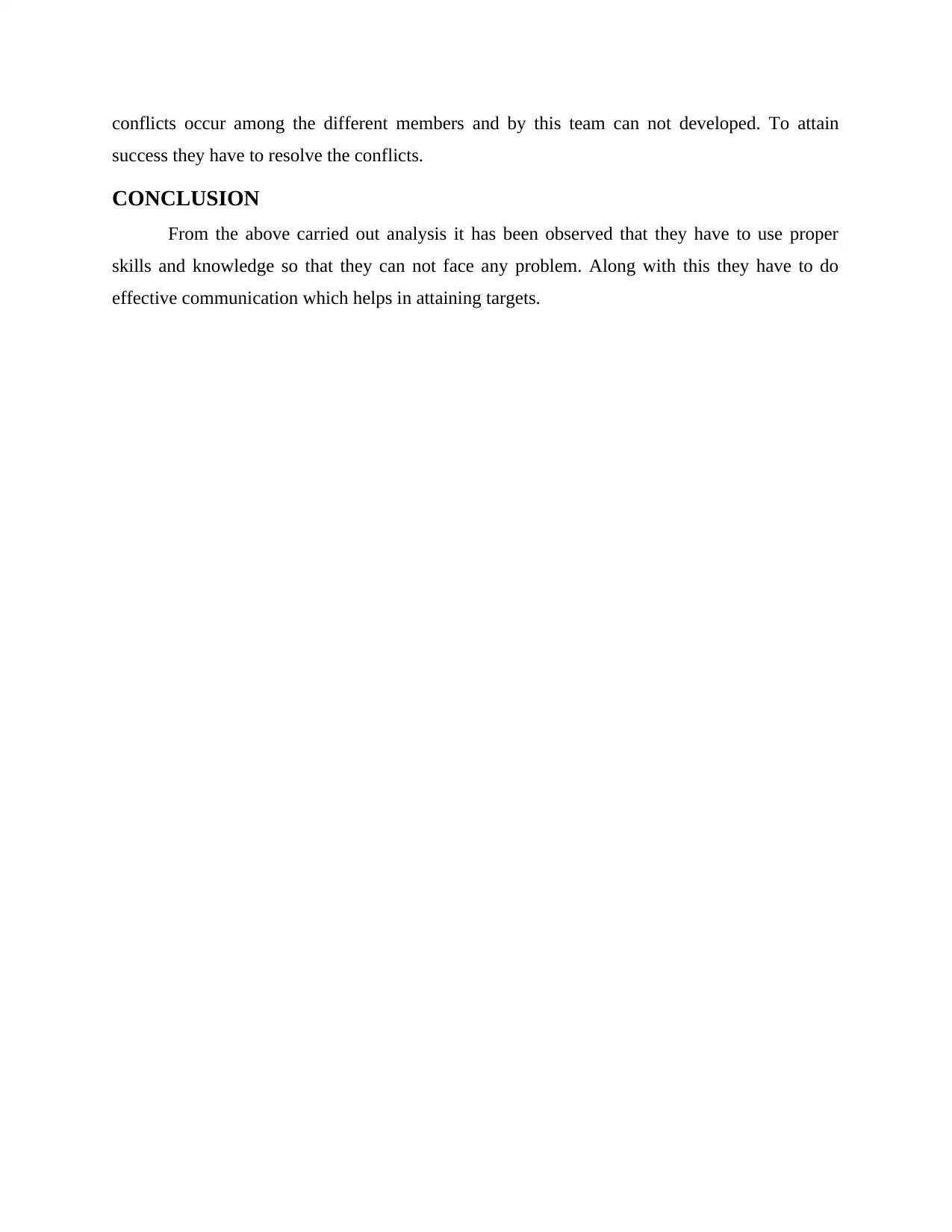
conflicts occur among the different members and by this team can not developed. To attain
success they have to resolve the conflicts.
CONCLUSION
From the above carried out analysis it has been observed that they have to use proper
skills and knowledge so that they can not face any problem. Along with this they have to do
effective communication which helps in attaining targets.
success they have to resolve the conflicts.
CONCLUSION
From the above carried out analysis it has been observed that they have to use proper
skills and knowledge so that they can not face any problem. Along with this they have to do
effective communication which helps in attaining targets.
⊘ This is a preview!⊘
Do you want full access?
Subscribe today to unlock all pages.

Trusted by 1+ million students worldwide
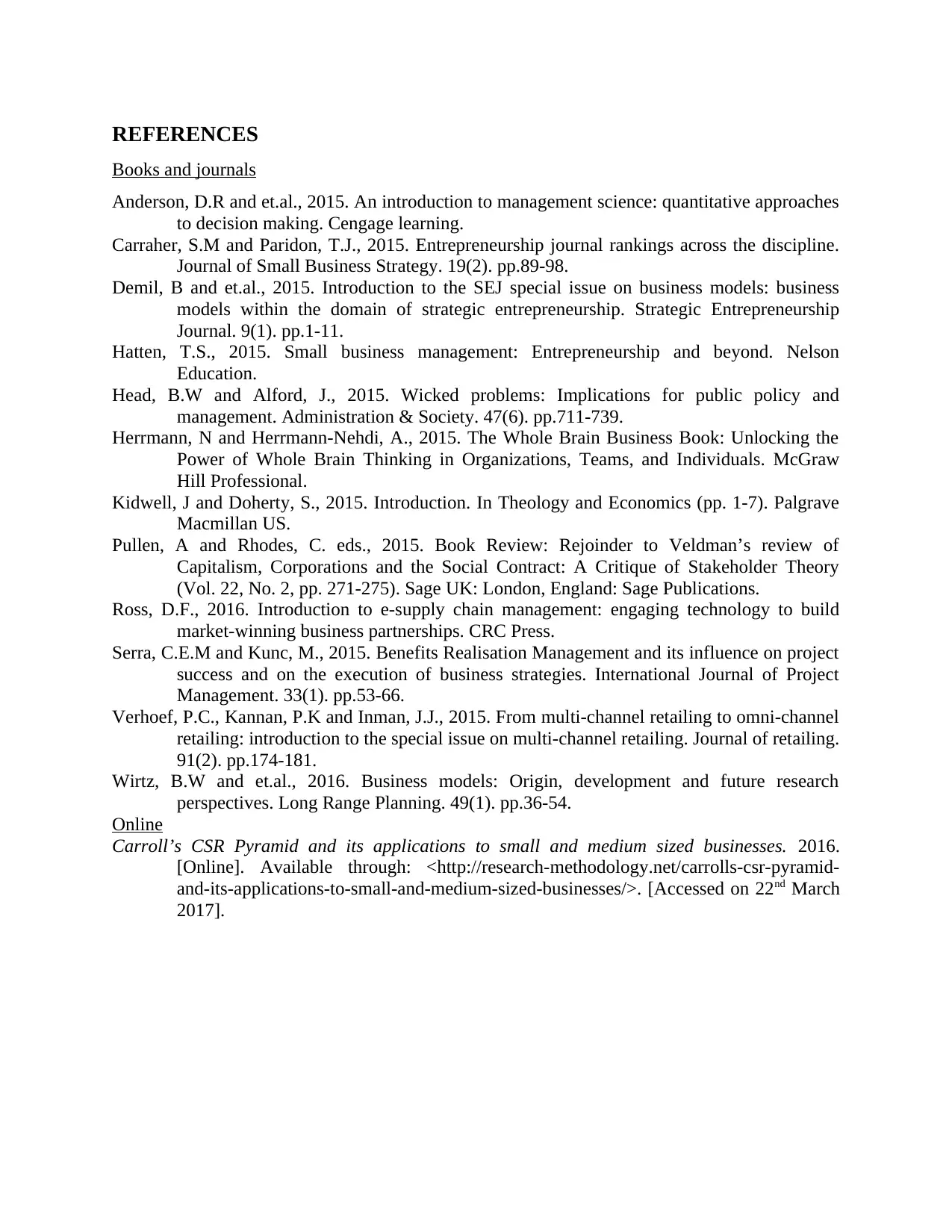
REFERENCES
Books and journals
Anderson, D.R and et.al., 2015. An introduction to management science: quantitative approaches
to decision making. Cengage learning.
Carraher, S.M and Paridon, T.J., 2015. Entrepreneurship journal rankings across the discipline.
Journal of Small Business Strategy. 19(2). pp.89-98.
Demil, B and et.al., 2015. Introduction to the SEJ special issue on business models: business
models within the domain of strategic entrepreneurship. Strategic Entrepreneurship
Journal. 9(1). pp.1-11.
Hatten, T.S., 2015. Small business management: Entrepreneurship and beyond. Nelson
Education.
Head, B.W and Alford, J., 2015. Wicked problems: Implications for public policy and
management. Administration & Society. 47(6). pp.711-739.
Herrmann, N and Herrmann-Nehdi, A., 2015. The Whole Brain Business Book: Unlocking the
Power of Whole Brain Thinking in Organizations, Teams, and Individuals. McGraw
Hill Professional.
Kidwell, J and Doherty, S., 2015. Introduction. In Theology and Economics (pp. 1-7). Palgrave
Macmillan US.
Pullen, A and Rhodes, C. eds., 2015. Book Review: Rejoinder to Veldman’s review of
Capitalism, Corporations and the Social Contract: A Critique of Stakeholder Theory
(Vol. 22, No. 2, pp. 271-275). Sage UK: London, England: Sage Publications.
Ross, D.F., 2016. Introduction to e-supply chain management: engaging technology to build
market-winning business partnerships. CRC Press.
Serra, C.E.M and Kunc, M., 2015. Benefits Realisation Management and its influence on project
success and on the execution of business strategies. International Journal of Project
Management. 33(1). pp.53-66.
Verhoef, P.C., Kannan, P.K and Inman, J.J., 2015. From multi-channel retailing to omni-channel
retailing: introduction to the special issue on multi-channel retailing. Journal of retailing.
91(2). pp.174-181.
Wirtz, B.W and et.al., 2016. Business models: Origin, development and future research
perspectives. Long Range Planning. 49(1). pp.36-54.
Online
Carroll’s CSR Pyramid and its applications to small and medium sized businesses. 2016.
[Online]. Available through: <http://research-methodology.net/carrolls-csr-pyramid-
and-its-applications-to-small-and-medium-sized-businesses/>. [Accessed on 22nd March
2017].
Books and journals
Anderson, D.R and et.al., 2015. An introduction to management science: quantitative approaches
to decision making. Cengage learning.
Carraher, S.M and Paridon, T.J., 2015. Entrepreneurship journal rankings across the discipline.
Journal of Small Business Strategy. 19(2). pp.89-98.
Demil, B and et.al., 2015. Introduction to the SEJ special issue on business models: business
models within the domain of strategic entrepreneurship. Strategic Entrepreneurship
Journal. 9(1). pp.1-11.
Hatten, T.S., 2015. Small business management: Entrepreneurship and beyond. Nelson
Education.
Head, B.W and Alford, J., 2015. Wicked problems: Implications for public policy and
management. Administration & Society. 47(6). pp.711-739.
Herrmann, N and Herrmann-Nehdi, A., 2015. The Whole Brain Business Book: Unlocking the
Power of Whole Brain Thinking in Organizations, Teams, and Individuals. McGraw
Hill Professional.
Kidwell, J and Doherty, S., 2015. Introduction. In Theology and Economics (pp. 1-7). Palgrave
Macmillan US.
Pullen, A and Rhodes, C. eds., 2015. Book Review: Rejoinder to Veldman’s review of
Capitalism, Corporations and the Social Contract: A Critique of Stakeholder Theory
(Vol. 22, No. 2, pp. 271-275). Sage UK: London, England: Sage Publications.
Ross, D.F., 2016. Introduction to e-supply chain management: engaging technology to build
market-winning business partnerships. CRC Press.
Serra, C.E.M and Kunc, M., 2015. Benefits Realisation Management and its influence on project
success and on the execution of business strategies. International Journal of Project
Management. 33(1). pp.53-66.
Verhoef, P.C., Kannan, P.K and Inman, J.J., 2015. From multi-channel retailing to omni-channel
retailing: introduction to the special issue on multi-channel retailing. Journal of retailing.
91(2). pp.174-181.
Wirtz, B.W and et.al., 2016. Business models: Origin, development and future research
perspectives. Long Range Planning. 49(1). pp.36-54.
Online
Carroll’s CSR Pyramid and its applications to small and medium sized businesses. 2016.
[Online]. Available through: <http://research-methodology.net/carrolls-csr-pyramid-
and-its-applications-to-small-and-medium-sized-businesses/>. [Accessed on 22nd March
2017].
1 out of 7
Related Documents
Your All-in-One AI-Powered Toolkit for Academic Success.
+13062052269
info@desklib.com
Available 24*7 on WhatsApp / Email
![[object Object]](/_next/static/media/star-bottom.7253800d.svg)
Unlock your academic potential
Copyright © 2020–2025 A2Z Services. All Rights Reserved. Developed and managed by ZUCOL.





